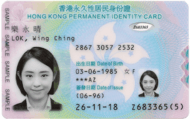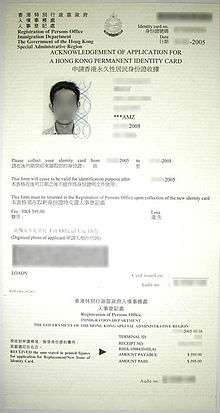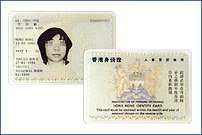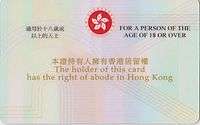Hong Kong identity card
The Hong Kong Identity Card (HKID) is an official identity document issued by the Immigration Department of Hong Kong. According to the Registration of Persons Ordinance (Cap. 177), all residents of age 11 or above who are living in Hong Kong for longer than 180 days must, within 30 days of either reaching the age of 11 or arriving in Hong Kong, register for an HKID.[2] HKIDs contain amongst others the name of the bearer in English, and if applicable in Chinese. The HKID does not expire for the duration of residency in Hong Kong.
| Hong Kong Identity Card 香港身份證 | |
|---|---|
 The front of the fourth-generation Hong Kong Permanent Identity Card | |
 The back of the fourth-generation Hong Kong Permanent Identity Card (with the right of abode in Hong Kong) | |
| Type | Identity card |
| Issued by | |
| Purpose | Identification |
| Eligibility | Residence in Hong Kong, person over 11 years of age |
| Cost | Registration: free[1] Renewal: free Replacement (lost, destroyed, damaged or defaced): HK$370 Replacement (alteration of particulars): HK$460 |
| Hong Kong Permanent Identity card | |||||||||||||||
|---|---|---|---|---|---|---|---|---|---|---|---|---|---|---|---|
| Traditional Chinese | 香港永久性居民身份證 | ||||||||||||||
| Cantonese Yale | Hēung góng wíhng gáu sing gēui màhn sān fán jing | ||||||||||||||
| |||||||||||||||
| Hong Kong Identity card | |||||||||||||||
| Traditional Chinese | 香港身份證 | ||||||||||||||
| Cantonese Yale | Hēung góng sān fán jing | ||||||||||||||
| |||||||||||||||
The Hong Kong Permanent Identity Card is a class of HKID issued to Hong Kong residents who have the right of abode (ROA) in the Hong Kong Special Administrative Region.[3] There are around 8.8 million Hong Kong identity cards in circulation.[4]
The current HKID, named as the New Smart Identity Card, features multiple security, durability and chip technology enhancements.[5]
History
| Demographics and culture of Hong Kong |
|---|
| Demographics |
|
| Culture |
| Other Hong Kong topics |
The use of identity documents has a long history in Hong Kong, starting with manually filled paper documents, to the smart card introduced on 23 June 2003.[2]
Before 1949, people could move freely into and out of Hong Kong (then a British colony), and China (then Republic of China). Hong Kong residents who held Republic of China citizenship were not registered. In 1949, when the Government of the Republic of China retreated to Taiwan and the People's Republic of China was established on the mainland, the Hong Kong Government began to register Hong Kong residents to issue compulsory identity documents.[6] These measures were put into practice to halt the large influx of refugees from Communist China and control the border with mainland China. The registration was completed in 1951. Although registration was compulsory for all residents, people were not required to carry their documents with them at all times when out in public.
Beginning on 1 June 1960, the government introduced the second generation of ID cards.[6] These bore the holder's fingerprint and photograph, and an official stamp. The information was typed, and the card was laminated. Males had a blue card and females had a red card. The format of card was replaced in November 1973 with a card without fingerprints.[6] The colour of the stamp identified and differentiated permanent residents (black) from non-permanent ones (green). New immigrants subsequently became known colloquially as "green stampers" (Chinese: 綠印客; Cantonese Yale: luhk yan haak).
From 24 October 1980, carrying an identity card in public areas and showing it when requested by a police or immigration officer became compulsory. This law was passed to control large numbers of illegal immigrants arriving in the territory. The government adopted a policy of deporting illegal immigrants within three days if they could not produce a valid ID card.
From March 1983, digitally processed identity cards were introduced to reduce forgery.[6] This also simplified border controls. On 1 June 1987, the Immigration Department produced cards without the coat of arms of British Hong Kong,[6] which would last through the handover on 1 July 1997. Following the handover the cards display a smaller seal of the Hong Kong Special Administrative Region in the back of the card. In 2003, the government began replacing the cards with smart ID cards in stages.
Hong Kong Smart Identity Cards
On 23 June 2003, the Immigration Department of Hong Kong began issuing a new Smart Identity card.[2] The new cards contained an embedded microchip, which stored the bearer's information electronically. Previous HKIDs remained valid until the Executive Council, through the Secretary for Security, declared them invalid. In addition, existing holders of HKIDs were called to have their old-style HKIDs replaced by the new cards. Between August 2003 to 2007, all Hong Kong ID cards were replaced.
The introduction of Smart Identity Cards was motivated partly to speed up processing at Hong Kong's Immigration checkpoints, especially with Shenzhen, China. In the latter checkpoint, an estimated 7,200 Hong Kong residents commuted daily to Shenzhen for work and 2,200 students from Shenzhen commuted to school in Hong Kong in 2002.
Hong Kong New Smart Identity Cards
In November 2017, the design of a new Smart ID card was introduced. The card is equipped with built-in radio frequency identification, expanded storage for higher-resolution photo, hologram background, rainbow printing, and micro-printed text. It was designed to prevent counterfeiting.[7]
On 27 December 2018, the Immigration Department started the replacement procedure for all existing Smart Cards under the Territory-wide Identity Card Replacement Exercise. The programme features 24 phases, from 2018 to 2022.[5]
Classes of HKID
There are two classes of Hong Kong Identity Card:
- Hong Kong Permanent Identity Card (Chinese: 香港永久性居民身份證) – states that the holder has the right of abode in the Hong Kong Special Administrative Region
- Hong Kong Identity Card (Chinese: 香港身份證) – which does not state that right.[3]
The card types can be further divided into cards bearing the term "child" (below age 11 and not compulsory. The card can be requested to obtain later a passport with a Hong Kong permanent resident number), "youth" (from age 11 up until 18), and "adult" (issued from age 18 onwards).
Permanent HKID and right of abode

Permanent HKID holders have the Right of Abode (Chinese: 居留權; Cantonese Yale: Gēuilàu kyùn) in Hong Kong. Under the Basic Law of Hong Kong, a person who belongs to one of the following categories is a permanent resident of the HKSAR with right of abode privileges:
- Chinese citizen born in Hong Kong before or after the establishment of the HKSAR
- Chinese citizen who has ordinarily resided in Hong Kong for a continuous period of not less than seven years before or after the establishment of the HKSAR.
- Person of Chinese nationality born outside Hong Kong before or after the establishment of the Hong Kong Special Administrative Region to a parent who, at the time of birth of that person, was a Chinese citizen falling within category (1) or (2).
- Person not of Chinese nationality who has entered Hong Kong with a valid travel document, has ordinarily resided in Hong Kong for a continuous period of not less than seven years and has taken Hong Kong as his place of permanent residence before or after the establishment of the HKSAR.
- Person under 21 years of age born in Hong Kong to a parent who is a permanent resident of the HKSAR in category (4) before or after the establishment of the HKSAR if at the time of his birth or at any later time before he attains 21 years of age, one of his parents has the ROA in Hong Kong.
- Person other than those residents in categories (1) to (5), who, before the establishment of the HKSAR, had the ROA in Hong Kong only.
Paper versions of the Hong Kong Identity card (such as the one on the right) are issued by the Registration of Persons Office for temporary use until a smart card can be manufactured. This process requires two weeks, and the smart card must be collected within six weeks.
Hong Kong Identity Card
The following conditions are required to receive a non-permanent Hong Kong Identity Card: (to be expanded)
- Right to Land – free from any condition of stay (including a limit of stay) or removal from HKSAR (and does not possess the right of abode)
- Anyone 11 years of age or above who enters and is permitted to stay in Hong Kong for more than 180 days
Eligibility
Residents of Hong Kong are required to obtain an HKID card at the age of 11. Hong Kong residents over age 15 are required to carry legal identification with them at all times (that is, the HKID card).[8] Bearers of a "youth" HKID card must switch to an "adult" HKID within 30 days after their 18th birthday. The "youth" card will be invalid as re-entry travel document 30 days after the 18th birthday.
Photographs are not required on HKIDs for children under the age of 11 and cannot be used as travel documents. A Hong Kong Re-entry Permit is issued in its place. Alternatively, children may use their HKSAR passport or their British National (Overseas) passport as a travel document to enter and exit Hong Kong.
HKID number
HKID cards contain the bearer's HKID number, of which the standard format is X123456(A). X represents any one or two letters of the alphabet. The letter U followed by any letter of the alphabet (UH and UY are common, though others exist) are usually given to mothers who have just given birth, but may or may not have right of abode in Hong Kong, and are therefore temporary until a proper number can be established. Also, babies cannot hold HKIDs but hospital filing systems are based on ID number, hence the need to assign temporary ones. The numerals may represent any Arabic number.
A is the check digit which has 11 possible values from 0 to 9 and A. There are 26 million possible card numbers using only the one-letter prefix, and 676 million using a two-letter prefix. The ID numbers of deceased persons are not reused. It is also noted that the check digit in brackets is not part of the identity card number, but appended solely to facilitate computer data processing.[9]
Physical appearance
First and second-generation computerised HKID


- Name in Chinese (if any)
- Name in English
- Name in Chinese Commercial Code (if any)
- Sex
- Date of birth
- Symbols
- Holder's digital image
- Month and year of first registration
- Date of registration
- Date of expiry (first-generation computerised Hong Kong ID card only)
- Identity card number (Note)
| Symbol | Description |
| *** | the holder is of the age of 18 or over and is eligible for a Hong Kong (S. A. R.) Re-entry Permit. |
| * | the holder is between the age of 11 and 17 and is eligible for a Hong Kong (S. A. R.) Re-entry Permit. |
| A | the holder has the right of abode in (the) Hong Kong (S. A. R.). |
| B | the holder's place of birth, date of birth or gender has been changed since his/ her first registration. |
| C | the holder's stay in (the) Hong Kong (S. A. R.) is limited by the Director of Immigration at the time of his registration of the card. |
| F | the holder is a female. |
| H1 | code of ID card issuing office |
| K2 | code of ID card issuing office |
| L | the holder has lost his/ her ID card once or more since his/ her first registration; 'L1' means he/ she has lost his/ her ID card once, 'L2' means twice, and so on.. |
| M | the holder is a male. |
| R | the holder has a right to land in (the) Hong Kong (S. A. R.). |
| S1 | code of ID card issuing office |
| U | the holder's stay in (the) Hong Kong (S. A. R.) is not limited by the Director of Immigration at the time of his registration of the card. |
| Y | the Immigration Department has verified the holder's reported date of birth by his/ her birth certificate or passport. |
| Z | the holder's place of birth reported is Hong Kong. |
| X | the holder's place of birth reported is the Mainland (mainland China). |
| W | the holder's place of birth reported is the region of Macau. |
| O | the holder's place of birth reported is in other countries. |
| N | the holder's name has been changed since his/ her first registration. |
The other difference between the first and second generation cards is the replacement of the Coat of Arms from the back, which was done to remove any colonial features in preparation for the handover in 1997.


Third and Fourth generation Smart HKID
- Name in Chinese (if any)[10]
- Name in English
- Name in Chinese Commercial Code (if any)
- Date of birth
- Sex
- Symbols
- Holder's digital image
- Month and year of first registration
- Date of (this) registration
- Identity card number
| Symbol | Description |
| *** | the holder is of the age of 18 or over and is eligible for a Hong Kong (S. A. R.) Re-entry Permit. |
| * | the holder is between the age of 11 and 17 and is eligible for a Hong Kong (S. A. R.) Re-entry Permit. |
| A | the holder has the right of abode in (the) Hong Kong (S. A. R.). |
| C | the holder's stay in (the) Hong Kong (S. A. R.) is limited by the Director of Immigration at the time of his registration of the card. |
| R | the holder has a right to land in (the) Hong Kong (S. A. R.). |
| U | the holder's stay in (the) Hong Kong (S. A. R.) is not limited by the Director of Immigration at the time of his registration of the card. |
| Z | the holder's place of birth reported is Hong Kong. |
| X | the holder's place of birth reported is the Mainland (mainland China). |
| W | the holder's place of birth reported is the region of Macau. |
| O | the holder's place of birth reported is in other countries. |
| B | the holder's place of birth or date of birth has been changed since their first registration. |
| N | the holder's name has been changed since their first registration. |
Names in Chinese and Roman script
It is common for Chinese Hong Kongers to adopt western-style English names (such as John, Mary, etc.), in addition to their phonetic English names, after being registered on the birth register. Some of them may wish to include their western-style English name as part of their official English name (this is known as 'adding an English name' locally). They can apply to the Immigration Department for including such name as part of their official English name (example: someone named 'Tai Ming CHAN' may have adopted a Western-style English name Peter and wish to have this name shown as 'Peter Tai Ming CHAN' ('Peter' as a first name) or 'Tai Ming Peter CHAN' ('Peter' as a middle name)) on his HKID card and the government's records. This is not considered by the Immigration Department as a name change. The Immigration Department considers that his or her original name (in the format of 'Tai Man CHAN') is an alias, and that the newly lodged name (usually in the format of 'Peter Tai Man CHAN' or 'Tai Man Peter CHAN' or CHAN Tai Man, Peter) is the proper name of the applicant (in the sense that such name is the 'proper name' of the applicant). A legal hangover from the former British administration is that the English transliteration of a persons Chinese name is their official legal name, and not their name in Chinese characters as would be expected.
Normally, when non-ethnic Chinese register for their first HKID card, the space reserved for a Chinese name is automatically left blank by the Immigration Department. It is possible, however, to add a name in Chinese characters at any time through application to the Immigration Department. Where a non-ethnic Chinese person applies to add a name in Chinese characters after first registration, this is considered by the Immigration Department as a name change.
Use as a travel document
The Hong Kong identity card by itself can be used to travel to Macau, as long as the holder has the right of abode or the right to land in Hong Kong, (the holder is able to stay for up to one year in Macau visa-free).[11]
Albania also accepts the Hong Kong permanent identity card by itself for entry, for a stay of up to 90 days within 180 days.[12]
Some foreign territories require Hong Kong Special Administrative Region passport holders to present their HKID as well to benefit from a visa exemption scheme: these places include Guam and the Northern Mariana Islands. Only HKSAR passport holders who were not born in Hong Kong or Macau are required to possess HKID when entering Taiwan.
HKID holders who possess right of abode or right to land are automatically eligible to use the e-Channel when arriving at or departing from Hong Kong. The e-Channel is not available when using an HKSAR passport and the person must clear immigration at an inspection counter if he or she arrives at or depart from a port of entry without HKID. Non-permanent residents are also eligible if they hold a Hong Kong Document of Identity for Visa Purposes or if they are successfully registered for e-Channel.[13]
Replacement schedule
The replacement schedule:[14]
| Cycle | Overdue Phase | Groups / Year of birth | Designated Period of Replacement |
|---|---|---|---|
| A | 1 | The Chief Executive, Members of the Executive Council, Members of the Legislative Council, Principal Officials, Members of the Immigration Service, Police Officers and Labour Inspectors | 27 December 2018 –
30 March 2019 |
| 2 | 1985 or 1986 | 21 January 2019 –
30 March 2019 | |
| 3 | 1968 or 1969 | 1 April 2019 –
1 June 2019 | |
| B | 4 | 1966 or 1967 | 3 June 2019 –
26 July 2019 |
| 5 | 1964 or 1965 | 27 July 2019 –
23 September 2019 | |
| 6 | 1955 or 1956 | 24 September 2019 –
15 November 2019 | |
| 7 | 1957 to 1959 | 16 November 2019 –
27 July 2020 | |
| C | 8 | 1960 or 1961 | 18 February 2020 –
27 July 2020 |
| Cycle | Current Phase | Year of birth | Designated Period of Replacement |
|---|---|---|---|
| C | 9 | 1962 or 1963 | 28 July 2020 - 22 September 2020 |
| Cycle | Upcoming Phase | Year of birth | Tentative Card Replacement Schedule (for reference only) |
|---|---|---|---|
| C | 10 | 1970 to 1972 | 23 September 2020 - 7 December 2020 |
| 11 | 1973 or 1974 | 8 December 2020 - 28 January 2021 | |
| 12 | 1975 or 1976 | 29 January 2021 - 19 March 2021 | |
| TBC | TBC | 1977 to 1984 | TBC |
| TBC | 1987 to 2000 | TBC | |
| TBC | 2005 to 2007 | TBC | |
| TBC | 2012 to 2018 | TBC | |
| TBC | 1954 or before | TBC |
See also
| Wikimedia Commons has media related to Hong Kong Identity Card. |
- Resident Identity Card used in the People's Republic of China
- Macau Resident Identity Card
- National Identification Card (Republic of China) used in the Republic of China
References
- Fee Tables – Immigration department of the Hong Kong SAR, archived from the original on 18 January 2017, retrieved 18 January 2017
- Immd.gov.hk. "immd.gov.hk Archived 10 February 2008 at the Wayback Machine." The government of the Hong Kong Special Administrative Region. Retrieved on 7 February 2008.
- Yearbook.gov.hk. "Yearbook.gov.hk Archived 24 January 2008 at the Wayback Machine." Hong Kong 2006. Retrieved on 7 February 2008.
- "New Hong Kong identity cards unveiled after 2 years; replacements begin Q4 2018 – Hong Kong Free Press HKFP". Hong Kong Free Press. 29 November 2017. Archived from the original on 23 April 2018. Retrieved 24 April 2018.
- "New Hong Kong ID cards to be rolled out from late December". South China Morning Post. 18 October 2018. Archived from the original on 20 December 2018. Retrieved 19 December 2018.
- Immd.gov.hk. "immd.gov.hk Archived 29 August 2006 at the Wayback Machine." Registration of persons, proof of identity. Retrieved on 7 February 2008.
- "This is what your next Hong Kong ID card will look like". South China Morning Post. 29 November 2017. Archived from the original on 20 December 2018. Retrieved 20 December 2018.
- "Hong Kong e-Legislation". Government of Hong Kong. Archived from the original on 16 October 2012. Retrieved 24 April 2018.
- "The Smart Identity Card | Immigration Department". Immigration Department, Hong Kong. Archived from the original on 1 August 2018. Retrieved 31 July 2018.
- Smartid.gov. "Smartid.gov Archived 3 July 2006 at the Wayback Machine." 'Smart ID FAQ. Retrieved on 7 February 2008.
- "e-Channel Service for Residents – Immigration Department". Government of Hong Kong. Archived from the original on 8 February 2015. Retrieved 24 April 2018.
- "Archived copy". Archived from the original on 19 December 2019. Retrieved 24 July 2017.CS1 maint: archived copy as title (link)
- "e-Channel Service for Residents". Immigration Department, Hong Kong. Archived from the original on 29 September 2017. Retrieved 24 April 2018.
- "New Smart Identity Card – Who shall replace identity cards?". Government of Hong Kong. Archived from the original on 23 August 2019. Retrieved 23 August 2019.